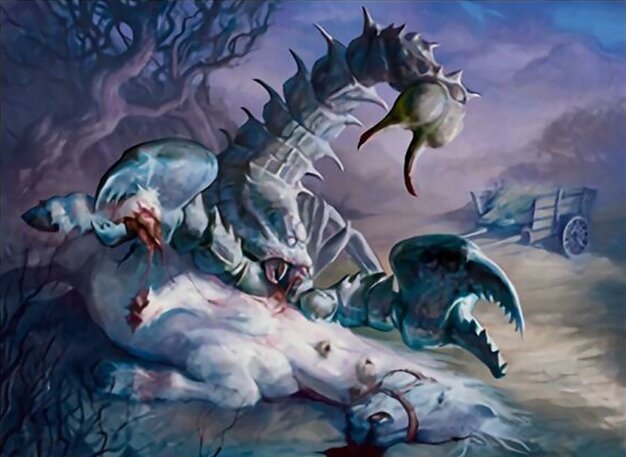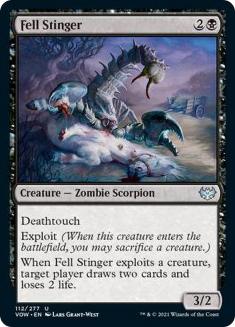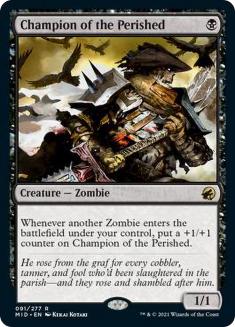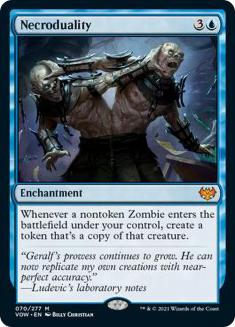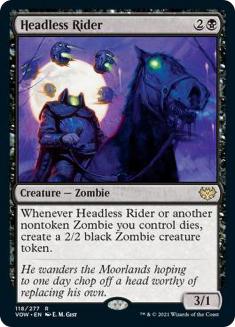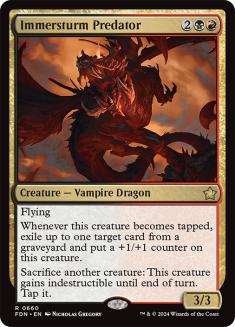Innistrad has always brought strong tribal themes and this latest iteration is no different. Given that Innistrad: Midnight Hunt focused on Werewolves while Innistrad: Crimson Vow focuses on Vampires, it’s easy to be drawn to those two tribes, but in my opinion Zombies look like the strongest tribe for Standard. And that opinion is largely driven by the power of the exploit mechanic.
Exploit in a vacuum isn’t particularly powerful. You have to sacrifice some of your position to gain whatever advantage the exploit trigger grants. Automatically, if that trigger doesn’t recoup the lost position, you’re making a difficult trade-off. Standard is often about playing to the battlefield, so I’m wary of any card that requires me to trade away material on the battlefield for anything off it.
However, if the payoffs are strong enough, exploit can be a powerful build-around mechanic. You already have Shambling Ghast and Jadar, Ghoulcaller of Nephalia as great sacrifice fodder that furthers the tribal theme, so it’s mainly a question of how powerful the exploit cards are. And I think Fell Stinger is excellent.
Turning a decayed Zombie token or a Shambling Ghast into two cards is a good trade, but again I’m wary of doing that to just draw cards, especially while I’m losing life. The chance of getting run over by an opposing aggro deck or losing key pressure against control is quite high. But the key is in the deathtouch on Fell Stinger. Even at a modest size of 3/2, it can trade for bigger creatures against Mono-Green Aggro❄ or attack through Smoldering Egg against Izzet Epiphany.
I also like that exploit allows plenty of versatility. If your early creatures die, you can simply cast it as a 3/2 to keep the pressure on. And late in the game, if you topdeck it on an empty battlefield, it can sacrifice itself and act as a Divination. So while you’ll want to build around it to consistently sacrifice something less valuable, you’re not pigeonholed into setting that up, making you less vulnerable to heavy removal strategies.
This means you can afford to add more exploit creatures without too much fear of overloading on them, provided they come with reasonable bodies. Creatures like Skull Skaab and Mindleech Ghoul don’t jump off the page stat-wise, yet can offer some ways to leverage tribal synergies and add disruption to a deck that is necessarily creature heavy. Graf Reaver is excellent for a more aggressive strategy, especially if more planeswalkers make their way into the metagame.
Overcharged Amalgam is the last exploit creature to consider, and despite reading the best it’s the one I’m least excited about. A deck with lots of creatures is going to tap out on its own turn a lot, making it more difficult to leave up four mana for a counterspell. It also has a prohibitive cost when you understand that blue is going to be the secondary color for any Zombie deck. There may be a different kind of deck that can utilize Amalgam, but it doesn’t fit in the kinds of decks I’m going to showcase today.
Let’s start with a deck that is built to maximize exploit by creating as many triggers as possible:
Creatures (28)
- 4 Shambling Ghast
- 4 Champion of the Perished
- 4 Jadar, Ghoulcaller of Nephalia
- 4 Bladestitched Skaab
- 4 Fell Stinger
- 4 Headless Rider
- 4 Skull Skaab
Lands (21)
Spells (11)

The key card here is Necroduality. Doubling all of your exploit creatures and Bladestitched Skaabs makes it very easy to snowball once you untap with it on Turn 5. It’s important to remember that Skull Skaab triggers whenever you exploit a nontoken creature, so if you make a copy you can get two tokens from each exploit trigger, whether from Skull Skaab itself or Fell Stinger.
A second copy of Fell Stinger also lets you refuel very quickly, digging for more exploit creatures, Headless Riders, or Bladestitched Skaabs to grow your battlefield to ludicrous proportions. That kind of card advantage can carry you in nearly any matchup that’s trying to control your battlefield with spot removal.
In the creature matchups, your snowballing battlefield will be enough to take over most games, so you can play more defensively. This is especially true after sideboarding when you have Geralf, Visionary Stitcher to jump your team to set up a lethal attack.
However, it’s important you work to end the game against any Alrund’s Epiphany deck, since given enough time they can combo-kill you. That’s where the aggression from Champion of the Perished and Bladestitched Skaab is so important. Champion can grow to 5/5 or bigger rather quickly when this deck is humming, and you can generate a huge number of Zombie tokens with Headless Rider, so Bladestitched Skaab can represent a lot of immediate damage. Just don’t be content to sit back with your huge battlefield. Prioritize ending the game.
I like the powerful synergies that this deck offers, but playing two colors in an aggro deck is always worrisome, so the next step was to explore a more streamlined and aggressive shell for Fell Stinger and exploit creatures:
Creatures (31)
- 4 Dungeon Crawler
- 4 Shambling Ghast
- 4 Champion of the Perished
- 4 Jadar, Ghoulcaller of Nephalia
- 4 Fell Stinger
- 4 Mindleech Ghoul
- 3 Henrika Domnathi
- 4 Headless Rider
Lands (21)
Spells (8)

Moving to Mono-Black means you have to replace Necroduality, Bladestitched Skaab, and Skull Skaab. Henrika Domnathi takes Necroduality’s spot at the top of the curve. You’ll often choose either the sacrifice or draw modes first to generate immediate value before setting up a transform on your next combat to attack with the transformed creature. That pattern plays well in this deck, so even though it’s not a Zombie, I like the addition. And the fact that it flies means you still have some ability to break through stalled battlefields, albeit a less powerful one.
Skull Skaab is now Mindleech Ghoul, which I chose over Graf Reaver because it has a much stronger exploit ability, even if it’s a weaker body. If the deck needs more aggression or many planeswalkers enter the metagame, you could easily swap it out for the 3/3.
Lastly, I replaced Bladestitched Skaab with Dungeon Crawler. This trade-off gives the deck less tribal synergy but a lower curve, and when you’re exploiting creatures you want to start building your battlefield as quickly as possible. This also gives the deck more aggression, which contributed to my previous decision to play Mindleech Ghoul over Graf Reaver. Increased aggression also makes it easier to overload on Infernal Grasps and have more versatile removal. Don’t go out of your way to try to trigger Dungeon Crawler. The venture cards are all weak and Savannah Lions is just fine in this deck.
Of course Faceless Haven is the major gain from trimming to one color, but I like Agadeem’s Awakening enough in this deck to play the full four copies and live with some awkward draws. It might look strange to play an aggro deck with effectively 25 lands, but you have card advantage from Fell Stinger and mana sinks in Agadeem’s Awakening and Faceless Haven. Aggro decks with high land counts are a favorite of mine, because they bring a level of consistency that is incredibly powerful for a deck whose job is to apply fast, consistent pressure to the opponent.
Once I saw the aggressive capabilities of this deck, I wanted to maximize those at the expense of some of the tribal synergies. Here’s the result of that experiment:
Creatures (32)
- 4 Scourge of the Skyclaves
- 2 Skyclave Shade
- 4 Dungeon Crawler
- 4 Shambling Ghast
- 4 Champion of the Perished
- 3 Jadar, Ghoulcaller of Nephalia
- 4 Fell Stinger
- 3 Henrika Domnathi
- 4 Graf Reaver
Lands (20)
Spells (8)

With Graf Reaver, Fell Stinger, Infernal Grasp, and Agadeem’s Awakening, you have enough life loss to make Scourge of the Skyclaves work. My VS Live! co-host Corey Baumeister first made that observation with a deck he played last week, but I didn’t like how high his curve was, given how powerful Scourge can be for only two mana. You really want to play a one-mana creature so you can cast Scourge on Turn 2 if necessary, so I went up to twelve while keeping enough Zombies to make Champion work. I also abandoned some of the sacrifice synergies in order to be more aggressive, which I think takes the best advantage of both Scourge and Graf Reaver.
This set up allows you to have curves like Turn 1 Dungeon Crawler, Turn 2 Agadeem + Scourge of the Skyclaves, Turn 3 Fell Stinger to pump your Scourge and turn Dungeon Crawler into two cards right as it’s about to be outclassed. That’s a completely realistic curve that offers card advantage, a major battlefield presence, and early aggression. Decks that can combine all three of those tend to be quite powerful in Standard.
The life loss theme and lower curve here also makes Sorin the Mirthless a valuable sideboard card against control decks. You don’t want too many four-drops and Henrika is still valuable as a solid threat that can cantrip unless your opponent has instant-speed removal, so two copies is more than enough.
The Dimir Zombie deck has the most powerful turns with Fell Stinger by virtue of Necroduality creating multiple copies, but I think this is the deck that utilizes Fell Stinger the best, because it’s the best at getting the opponent dead.
That said, we can maximize the sacrifice aspect of Fell Stinger by moving away from the Zombie theme entirely. Thinking along those lines led me to the following list:
Creatures (31)
- 3 Skyclave Shade
- 4 Immersturm Predator
- 2 Extus, Oriq Overlord
- 4 Eyetwitch
- 4 Shambling Ghast
- 3 Jadar, Ghoulcaller of Nephalia
- 3 Morbid Opportunist
- 4 Fell Stinger
- 4 Mindleech Ghoul
Lands (21)
Spells (8)

Moving away from the Zombie theme means Eyetwitch makes a return as the companion to Shambling Ghast. The two-slot on the curve is also dominated by sacrifice creatures in Jadar and Skyclave Shade, though I like Mindleech Ghoul here as a way to get more disruption in the deck as well as allow for Shambling Ghast-Mindleech Ghoul openings that can ramp into Immersturm Predator on Turn 3.
Immersturm Predator is the real gain from moving to red, since it’s such a powerful creature, even in a metagame with lots of bounce spells. It can dominate the battlefield and supercharge the sacrifice synergies, especially with Morbid Opportunist.
It’s also a Dragon for Dragon’s Fire, letting you bias the removal suite away from Infernal Grasp without sacrificing much in the way of versatility. You could also explore moving fully into white as opposed to just taking the free splash off Pathways for Extus, which would let you play the underrated Vanishing Verse as your removal spell. But I always err on the side of consistency.
This deck isn’t as aggressive as some of the previous lists, but it has more powerful cards, good interaction, and a ton of card advantage built into its creatures. I’d love to have more discard in the sideboard against Epiphany, but the Lesson package takes up significant space. I’m hopeful that adding another set to Standard can supercharge the aggressive decks to the point of pushing out Alrund’s Epiphany to some degree, thereby making space in the metagame for traditional midrange strategies. This deck would love to play in such a metagame, given how versatile it is, playing both offense and defense.
There are lots of ways to take advantage of Fell Stinger and exploit creatures. But the common denominators are having good, cheap sacrifice fodder like Shambling Ghast; Jadar, Ghoulcaller of Nephalia; and Eyetwitch, plus the ability to play aggressively since the exploit synergies offer you built-in staying power. Exactly how many exploit creatures and enablers you want and just how aggressive you should be will depend on specific metagame conditions, but as Standard grows I’ll be surprised if these kinds of synergistic aggressive decks don’t start to take form and make an impression on the metagame.

